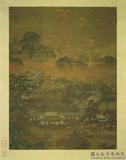明文徵明琴鶴圖清高宗御題 軸
推薦分享
資源連結
連結到原始資料 (您即將開啟新視窗離開本站)後設資料
- 資料識別:
- 故畫002197N000000000
- 資料類型:
- 類型:繪畫
- 型式:靜態圖像
- 著作者:
- 文徵明
- 主題與關鍵字:
- 松 芭蕉 萱花 齋館 鶴 文玩(琴棋書畫) 花器 房舍 梧桐 竹 侍從(侍女、童僕) 高士(士人、隱士)
- 出版者:
- 數位化執行單位:國立故宮博物院
- 格式:
- 本幅 63.4x29.2公分、全幅 60公分
- 關聯:
- 石渠寶笈三編(延春閣),第四冊,頁1924&*故宮書畫錄(卷八),第四冊,頁80&*故宮書畫圖錄,第七冊,頁165-166&* 文徵明(一四七○-一五五九),初名壁,以字行,更字徵仲,號衡山居士,長洲(江蘇蘇州)人,為明代吳派領導畫家。五十四歲以歲貢至京,授翰林待詔,與修武宗實錄,後厭倦京師生活,返居故里,專意藝事。 本幅設色界畫重樓敞軒,賓主二人坐堂上對語,庭前桐蔭高松,一鶴啄苔,一童子捧琴至。筆墨清勁,設色雅淡,樓閣雖作界畫法,仍保持文人畫家雅逸之氣息。 &* Wen Cheng-ming was a native of Ch’ang-chou in Kiangsu province. Although his given name was Pi, he was best known by his style name Cheng-ming. Another style name was Cheng-chung. His sobriquet was Heng-shan chü-shih. He was the most influential leading master of the Wu school. At the age of fifty-three, he was recommended to the emperor as a tribute student, and received a position as Academician Awaiting Orders in the prestigious Institute of Academicians. he participated in editing the Wu-tsung shih-lu (Records of Emperor Wu-tsung). Later, he tired of the official life and returned to his hometown where he spent the rest of his life creating art works. This colored ruled-line painting consists of a two-storied pavilion with an open-air room on the first floor. There, the guest and host are conversing with each other. Pines and firmiana trees stand in the garden. A crane is picking up a piece of moss, and a servant boy is carrying a ch’in (Zither) to the hut. Color is refined. Although Wen Cheng-ming used a fine ruled-line painting style to depict the architecture, the work reveals a graceful and casual atmosphere which maintains the spirit of literati painting. &*1.國立故宮博物院編輯委員會,〈明文徵明琴鶴圖〉,收入國立故宮博物院編輯委員會編,《界畫特展圖錄》(臺北:國立故宮博物院,1986年初版),頁62。 2.江兆申,〈文徵明琴鶴圖 軸〉,收入國立故宮博物院編,《吳派畫九十年展》(臺北:國立故宮博物院,1975年初版,1976年再版,1981年三版),頁317。
- 管理權:
- 國立故宮博物院
授權聯絡窗口
- 國立故宮博物院圖像授權、出版授權、影音資料授權-申請流程說明
http://www.npm.gov.tw/zh-TW/Article.aspx?sNo=03003061






